Chapter 16
Practice Exam 1
You’re now ready to take a practice GRE. Like the actual, computer-based GRE, the following exam consists of two 30-minute essays, two 30-minute Verbal Reasoning sections (20 questions each), and two 35-minute Quantitative Reasoning sections (20 questions each). The actual GRE may also include an extra Verbal or Quantitative Reasoning section, which doesn’t count toward your score, but this practice exam has nothing like that.
Take this practice test under normal exam conditions and approach it as you would the real GRE:
 Work when you won’t be interrupted.
Work when you won’t be interrupted.
 Use scratch paper that’s free of any prepared notes. On the actual GRE, you receive blank scratch paper before your test begins.
Use scratch paper that’s free of any prepared notes. On the actual GRE, you receive blank scratch paper before your test begins.

 Answer as many questions as time allows. Consider answering all the easier questions within each section first and then going back to answer the remaining, harder questions. Because you’re not penalized for guessing, go ahead and guess on the remaining questions before time expires.
Answer as many questions as time allows. Consider answering all the easier questions within each section first and then going back to answer the remaining, harder questions. Because you’re not penalized for guessing, go ahead and guess on the remaining questions before time expires.
 Set a timer for each section. If you have time left at the end, you may go back and review answers (within the section), move on and finish your test early, or kick back and relax until time expires.
Set a timer for each section. If you have time left at the end, you may go back and review answers (within the section), move on and finish your test early, or kick back and relax until time expires.
 Don’t leave your desk while the clock is running on any section.
Don’t leave your desk while the clock is running on any section.
 Take a one-minute break after each section and the optional ten-minute break after the first Verbal section.
Take a one-minute break after each section and the optional ten-minute break after the first Verbal section.
 Type the essays. Because you type the essays on the actual GRE, typing them now is good practice. Don’t use software, such as Microsoft Word, with automatic spellchecker or other formatting features. Instead, use a simple text editor, such as Notepad, with copy and paste but no other features. The GRE essay-writing field features undo, redo, copy, and paste functionality but nothing else.
Type the essays. Because you type the essays on the actual GRE, typing them now is good practice. Don’t use software, such as Microsoft Word, with automatic spellchecker or other formatting features. Instead, use a simple text editor, such as Notepad, with copy and paste but no other features. The GRE essay-writing field features undo, redo, copy, and paste functionality but nothing else.
After completing this entire practice test, go to Chapter 17 to check your answers with the answer key and go through the answer explanations to all the questions, not just the ones you miss. The answer explanations provide a plethora of valuable insight — material that provides a good review of everything you went over in the previous chapters. Reviewing answer explanations to all the questions also ensures that you understand the reason why any answers you guessed correctly are correct.
Answer Sheet
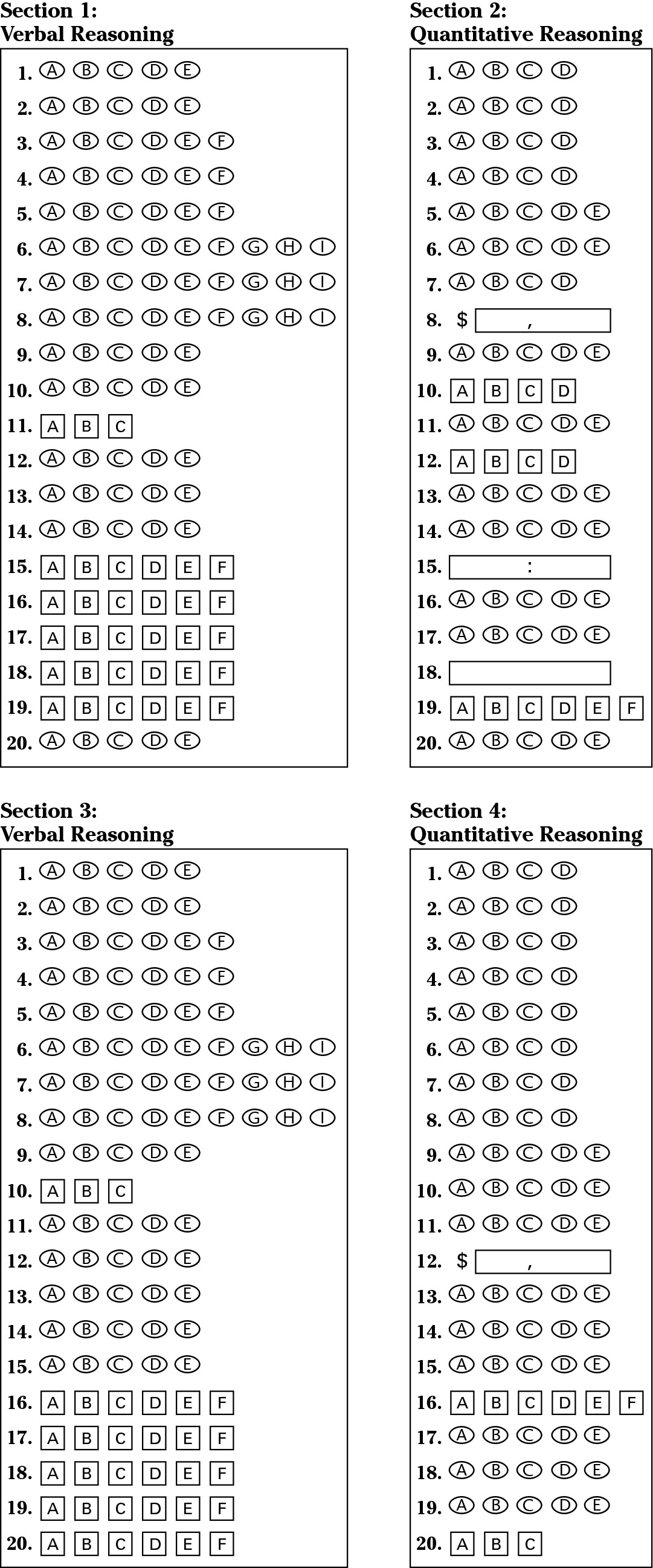
Analytical Writing 1: Analyze an Issue
Time: 30 minutes
Directions: Present and explain your view on the following issue. Although there is no one right or wrong response, be sure to consider various points of view as you explain the reasons behind your own perspective. Support your position with reasons and examples from your own reading, personal or professional experience, and observations.
“The right to bear arms is not the direct cause of the level of violence in a country.”
Express the extent to which you agree or disagree with the preceding statement and explain the reasoning behind your position. In support of your position, think of ways in which the statement may or may not be true and how these considerations influence your position.
Analytical Writing 2: Analyze an Argument
Time: 30 minutes
Directions: Critique the following argument. Identify evidence that will strengthen or weaken the argument, point out assumptions underlying the argument, and offer counterexamples to the argument.
The following appeared in a memo sent by an outside efficiency expert hired by a firm to evaluate employee performance.
“In the six months that I have been watching the employees, their productivity has increased by over 12 percent. Therefore, my recommendation is that the employees either be watched by, or think that they are watched by, an outside evaluator at all times from this point on.”
Discuss the merits of the preceding argument. Analyze the evidence used as well as the general reasoning. Present points that would strengthen the argument or make it more compelling.
Section 1
Verbal Reasoning
Time: 30 minutes for 20 questions
Directions: Choose the best answer to each question. Blacken the corresponding oval(s) on the answer sheet.
Directions: For Questions 1–8, choose the one entry best suited for each blank from its corresponding column of choices.
1. With countries around the world struggling to finance their current obligations, most world leaders are _____ to pledge additional money to fund international initiatives.
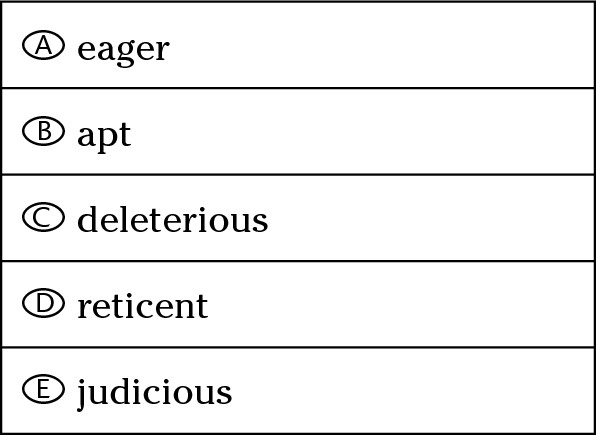
2. Thousands of feet below the ocean’s surface at depths that even light cannot penetrate is a world of creatures that _____ human imagination.
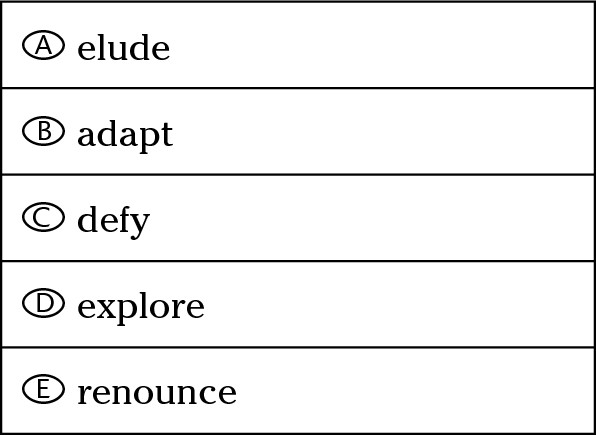
3. Although Mary was (i)_____ in the way she dressed, her housekeeping was (ii)_____.
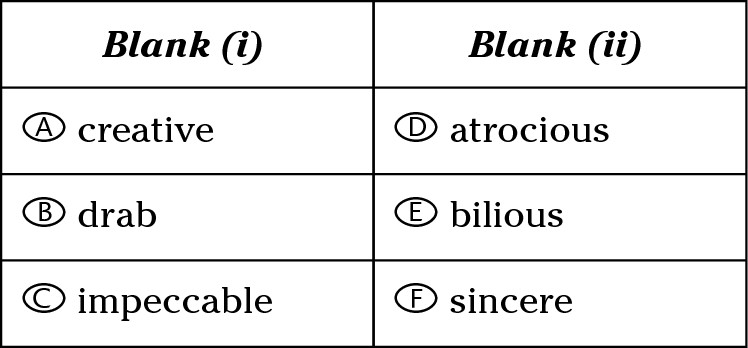
4. Feeling a greater sense of (i)_____, baby boomers tend to be (ii)_____.
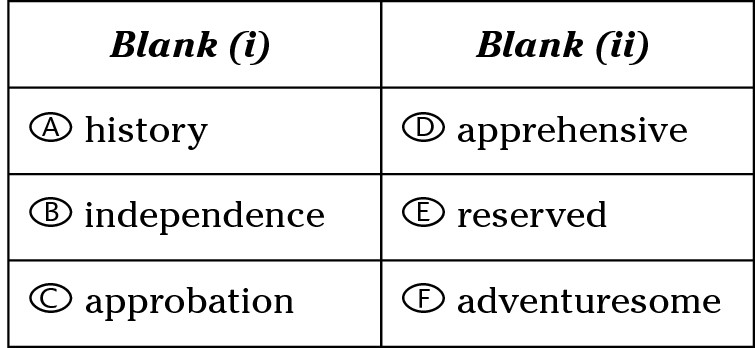
5. The Presidio of San Francisco is an architectural (i)_____, exhibiting numerous (ii)_____ styles, including the small Funston Avenue cottage with a large mansard roof.
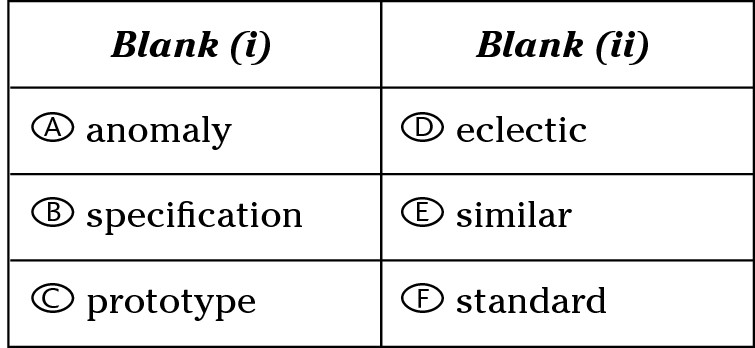
6. Though 5 feet in length and resembling the (i)_____ cottonmouth, the Northern Water Snake is relatively (ii)_____. Despite this fact, even in areas uninhabited by cottonmouths, the Northern Water Snake is commonly killed based on (iii)_____ fears.

7. Theodore “Teddy” Roosevelt once said, “Speak softly and carry a big stick,” but his actions (i)_____ his words. He was actually one of the most (ii)_____ heroes of the Spanish-American War and was known for being quite (iii)_____.

8. In an attempt to (i)_____ other members of the school board, the school board president made numerous (ii)_____ that mitigated some of the more (iii)_____ issues.

Directions: Each of the following passages is followed by questions pertaining to the passage. Read the passage and answer the questions based on information stated or implied in that passage. For each question, select one answer choice unless instructed otherwise.
The Canyon Pintado Historic District in northwest Colorado was occupied by numerous prehistoric peoples for as long as 11,000 years, including the Fremont culture that left behind rock-art sites. Fremont rock art has recurring motifs that link it to other cultures in that time period. Strange humanlike figures with broad shoulders, no legs, and horned headdresses are similar to the Barrier Canyon style of southwestern Utah. Figures with shields or shieldlike bodies are like Fremont figures from the San Rafael region of Southern Utah.
Some figures have large, trapezoidal-shaped bodies, sticklike legs, trapezoidal heads, and in many cases, are adorned with necklaces. Another motif of the Fremont culture is the mountain sheep, with graceful curvilinear horns. Designs such as concentric circles, snakelike lines, hands, corn plants, and rows of dots are also often found in Fremont art. A unique figure in Douglas Creek is Kokopelli, the humpbacked flute player of Anasazi mythology. His presence indicates some kind of tie with the more advanced culture of the Four Corners area.
9. The author mentions the connection to the culture of the Four Corners area to
A Challenge the claim that the Fremont culture was the most advanced of its time.
B Refute the assertion that Fremont rock art merely copied art from other cultures.
C Suggest that the mimicking of art from other cultures may indicate contact between the cultures.
D Prove the relationship between art and the level of civilization.
E Ridicule the suggestion that there is a connection between artistic images and warfare success.
10. In which sentence of the passage does the author identify what links Fremont rock art to other cultures in the same time period?
A The first sentence (“The Canyon Pintado . . . sites.”)
B The second sentence (“Fremont rock . . . period.”)
C The third sentence (“Strange humanlike . . . Utah.”)
D The fourth sentence (“Figures . . . Utah.”)
E The last sentence (“His presence . . . area.”)
The war that many people commonly refer to as the Civil War has had many appellations throughout history. While the war was being fought, the South labeled it the “War Between the States.” Sundry Southerners used the term “The Second American Revolutionary War,” emphasizing their belief that they were attempting to secede from what they considered a tyrannical federal government.
One primary etiology of the Civil War may have been the 1820 Missouri Compromise. The compromise admitted Missouri into the Union as a slave state, while accepting Maine as a free state. The compromise also banned slavery in all western territories. However, it wasn’t until 1860 when Abraham Lincoln, who was known to be against slavery, was elected president that South Carolina withdrew from the Union. At that time, the president was James Buchanan, who did not fight against the secession. By 1860, six more states had withdrawn, banding together to form the Confederate States of America, which eventually was comprised of 11 states. Their president was Jefferson Davis; the Confederacy’s capital, which originally was Montgomery, Alabama, moved to Richmond, Virginia.
The first battle of the Civil War was fought at Bull Run in Virginia. Schoolchildren today are still told how the local people treated the battle as if it were a social event, taking picnic baskets and sitting on top of the hill to watch the fighting. The Federal troops lost the battle and had to retreat. Later, there was a Second Battle of Bull Run, which the Union lost as well.
General Ulysses S. Grant, later president of the United States, gained fame as a great Civil War strategist. When he captured Vicksburg, Mississippi, he made it possible for the Union to control all the Mississippi River, a critical point given that goods were often shipped along that river. The Union, therefore, was able to prevent materials from reaching the Confederate troops, a situation which many historians considered essential to the quick termination of the war. Grant had the honor of receiving the surrender of the South from General Robert Lee at Appomattox Courthouse, near Richmond, Virginia, on April 9, 1865. It was only five days later that President Lincoln was assassinated.
The Civil War was the first war to have photographers, leaving to posterity the real evidence of the battles. This war also was more industrialized than many other wars, employing railroads, iron ships, and submarines.
For the following question, consider each answer choice separately and select all answer choices that are correct.
11. All of the following were discussed in the passage:
A The causes of the Civil War
B The South after the Civil War
C Great generals of the Civil War
12. The author would best strengthen his point in the first paragraph by doing which of the following?
A Supplying alternate names that the Northerners called the Civil War
B Explaining the ambiguity of the term “Civil” War
C Listing reasons the South wanted to secede from the Union
D Discussing the actions the North had taken that the South considered tyrannical
E Refuting the common misconception that slavery issues caused the Civil War
13. By stating, “It was only five days later that President Lincoln was assassinated,” the author implies that
A Southern troops fighting the war had made their way to the capital seeking revenge on Lincoln.
B The president was improperly protected because the guards believed that when the war had ended, there was little threat to Lincoln.
C The course of history, especially the reconstruction of the country and rehabilitation of the former slaves, would have been greatly altered had Lincoln lived to serve out his term.
D There may have been a connection between the end of the war and the assassination.
E The former Confederate government wanted a chance to place its people in positions of power.
14. Which of the following statements would most logically follow the last sentence of the passage?
A The photographs proved that the Civil War was the bloodiest war ever fought on American soil.
B The new technology, especially submarines, gave the North an advantage in the war that the less industrialized South did not possess.
C Many of the photographs are kept in the Smithsonian Museum in Washington, D.C.
D People not fighting directly in the war were, for the first time, able to comprehend the reality of the war.
E The railroad technology developed during this time led eventually to the expansion of the West.
Directions: Each of the following sentences has a blank indicating that a word or phrase is omitted. Choose the two answer choices that best complete the sentence and result in two sentences most alike in meaning.
15. Although the governor was frugal in managing the state’s budget, he could be quite _____ when making personal purchase decisions.
A extravagant
B impulsive
C generous
D profligate
E enigmatic
F erroneous
16. The defense attorney presented a host of exculpatory evidence in an attempt to _____ her client.
A incriminate
B exonerate
C castigate
D legitimize
E forgive
F vindicate
17. Given the complexity of the issue, the audience was pleasantly surprised to hear the committee deliver such a _____ summary of the solution.
A succinct
B discursive
C laconic
D historic
E sardonic
F euphemistic
18. Like many writers and artists, Virginia Woolf, though very prolific, struggled with her own _____ moods.
A ebullient
B effusive
C spasmodic
D saturnine
E sinister
F melancholy
19. The mayor’s _____ remarks insulted so many politicians in both parties that city councilmembers began demanding his resignation.
A enthusiastic
B acerbic
C encouraging
D reassuring
E sardonic
F confident
Directions: The following passage is followed by a question pertaining to the passage. Read the passage and answer the question based on information stated or implied in the passage. Select only one answer.
This passage is an excerpt from A History of Modern Latin America: 1800 to the Present by Teresa A. Meade (Wiley-Blackwell).
Latin America is a vast, geographically and culturally diverse region stretching from the southern border of the United States to Puerto Toro at the tip of Chile, the southernmost town of the planet. Encompassing over 8 million square miles, the 20 countries that make up Latin America are home to an estimated 550 million people who converse in at least five European-based languages and six or more main indigenous languages, plus African Creole and hundreds of smaller language groups.
20. According to this passage, the boundaries of Latin America are
A United States and Mexico
B United States and the southern tip of Chile
C Canada and Chile
D Puerto Toro and Chile
E Mexico and Guatemala

Section 2
Quantitative Reasoning
Time: 35 minutes for 20 questions
Notes:
 All numbers used in this exam are real numbers.
All numbers used in this exam are real numbers.
 All figures lie in a plane.
All figures lie in a plane.
 Angle measures are positive; points and angles are in the position shown.
Angle measures are positive; points and angles are in the position shown.
Directions: For Questions 1–4, choose from the following answer choices:
A Quantity A is greater.
B Quantity B is greater.
C The two quantities are equal.
D The relationship cannot be determined from the information given.
1. a is an integer greater than zero

2. 0 > a > b > c

3.
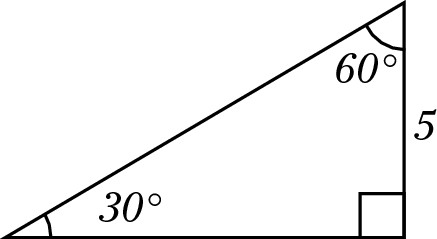

4. 16a + 5b = 37; 3b – 8a = –21

5. Square RSTU has a perimeter of 48. If A, B, C, and D are the midpoints of their respective sides, what is the perimeter of Square ABCD?
A 32
B 
C 24
D 
E 
6. Gigi and Neville, working together at the same rate, can mow the estate’s lawn in 12 hours. Working alone, what fraction of the lawn can Gigi mow in three hours?
A 
B 
C 
D 
E 
The answer choices for Question 7 are
A Quantity A is greater.
B Quantity B is greater.
C The two quantities are equal.
D The relationship cannot be determined from the information given.
7.
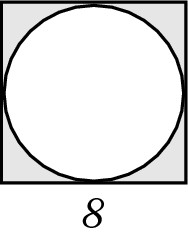

Use the following graphs to answer Questions 8–10.
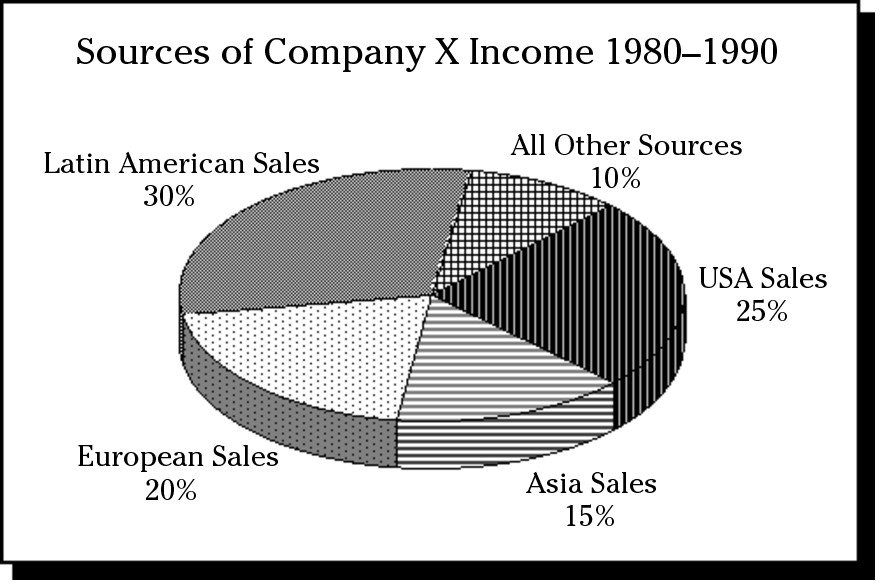
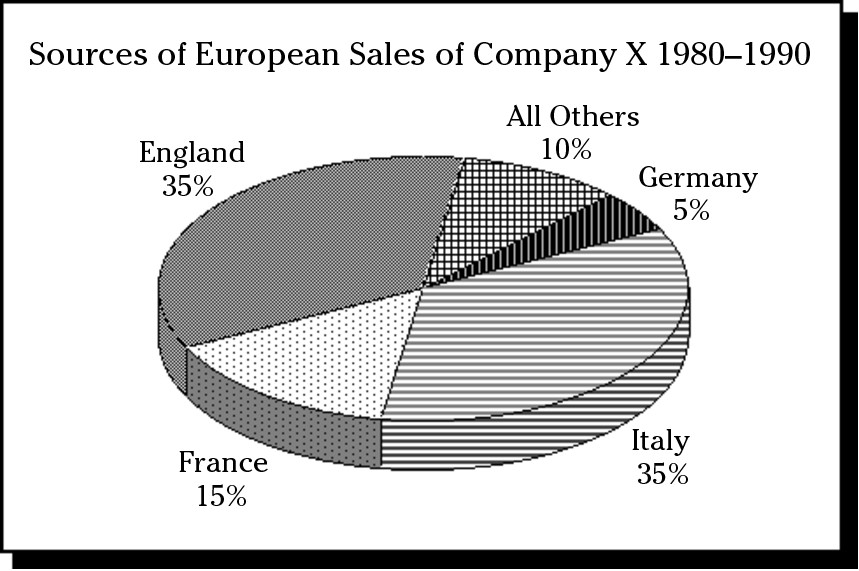
8. If Company X received $50,000 in Latin American Sales from 1980 through 1990, how much money did it receive from sales to France?
Give your answer to the nearest thousand.

9. From the information given, the 1985 sales to England were what percent of the sales to Europe?
A 100
B 50
C 35
D 25
E It cannot be determined.
For the following question, choose exactly two answer choices.
10. From the information given, sales to France accounted for which of the following in European sales?
A Half as much as sales to Italy and Germany combined
B Exactly 20% of total European sales less than to either Italy or England
C 20% of total European sales less than England and 10% of total European sales more than Germany
D More than half as much as sales to Italy
11. If x ≠ –1 or 0 and  , then
, then 
A 1
B 3
C x
D x + 1
E 
For the following question, choose exactly two answer choices.
12. If 5(x + 2)2 – 125 = 0, then x =
A 3
B –3
C –7
D 25
13. If ten plums cost a cents and six apples cost b cents, what is the cost of two plums and two apples in terms of a and b?
A 
B 3a + 5b
C 15ab
D 
E 
14. If x ≠ 4, solve for  .
.
A –1
B 
C 
D 
E 
15. Each of two right circular cylinders has a height of 10. Cylinder A has a circumference of 10. Cylinder B has a circumference of 20. What’s the ratio (in its simplest terms) of the volume of Cylinder A to the volume of Cylinder B?

16. A plane flies from Los Angeles to New York at 600 miles per hour and returns along the same route at 400 miles per hour. What is the average (arithmetic mean) flying speed for the entire route?
A 460 mph
B 480 mph
C 500 mph
D 540 mph
E It cannot be determined from the information given.
17. The slope of a line segment with points (3, 2) and (8, 14) is:
A 
B 1.5
C 
D 2.4
E 4.2
18. If a is the smallest prime number greater than 7 and b is the largest prime number less than 19, then ab =

For the following question, choose all answer choices that apply.
19. 
Which of the following integers makes the preceding equation true?
A –21
B 15
C –15
D 20
E –32
F 6
20. 7x + 4y = 53
9x – 4y = –5
If x and y make the preceding system of equations true, what is the value of x × y?
A –69
B –24
C 16
D –16
E 24

Section 3
Verbal Reasoning
Time: 30 minutes for 20 questions
Directions: Choose the best answer to each question. Blacken the corresponding oval(s) on the answer sheet.
Directions: For Questions 1–8, choose the one entry best suited for each blank from its corresponding column of choices.
1. Marcella approached her latest project with such _____ that her boss not only took her off probation but also gave her a raise.
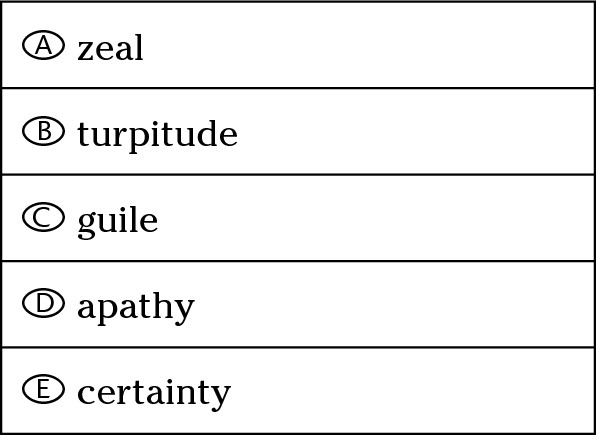
2. The mayor’s tendency toward being _____ was well known, so her recent outburst was no surprise.
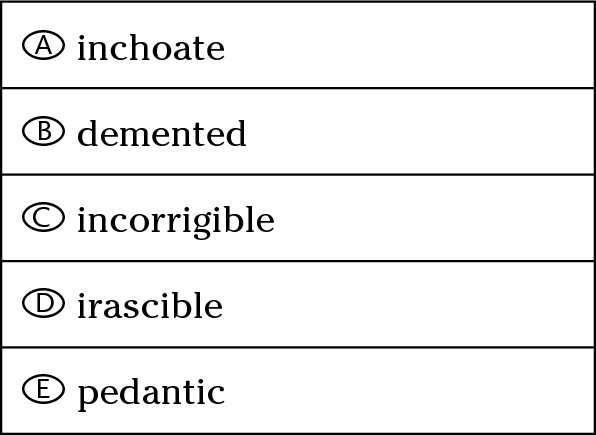
3. Given his predecessor’s (i)_____ reputation, the new manager decided to (ii)_____ her leadership style rather than change it.
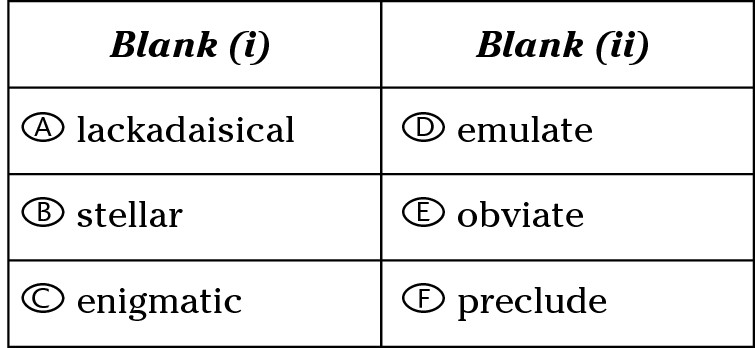
4. The speaker was extremely (ii)_____, bringing the audience to a peaceful (ii)_____.
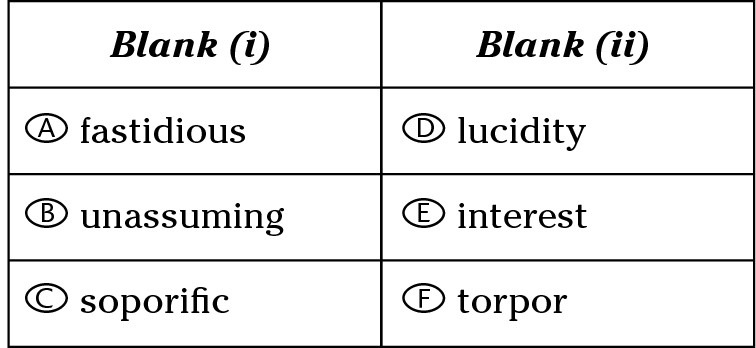
5. One of the possum’s primary (i)_____ maneuvers is to (ii)_____ death until a potential predator loses interest.
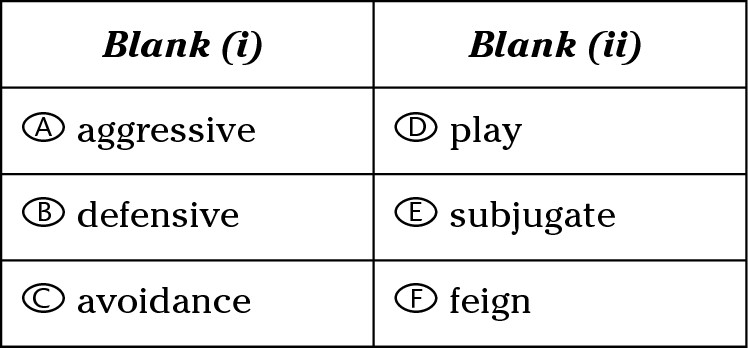
6. The instructions were so (i)_____ that the possibility anyone could (ii)_____ them was completely (iii)_____.

7. The crowd’s exuberance was (i)_____. Soon after they dispersed, a riot (ii)_____, and even some of the most (iii)_____ of the group brandished weapons.

8. Unable to arrive at a (i)_____, attorneys for the two parties engaged in (ii)_____ to resolve the (iii)_____.

Directions: Each of the following passages is followed by questions pertaining to the passage. Read the passage and answer the questions based on information stated or implied in that passage. For each question, select one answer choice unless instructed otherwise.
The following passage was taken from Alternative Energy For Dummies by Rik DeGunther (Wiley).
Humans have evolved in step with sophistication of their energy consumption. Human populations, quality of life, and life expectancy have increased as energy sources have become more sophisticated.
Think about it: Early man couldn’t even light a fire. Many froze in the winter, with only wooly mammoth skins to keep them warm, and the quality of life was not much different than that of animals. Once fire was discovered and humans were able to create flames at will, humanity began a gradual but consistent climb from savagery to what it is today. Upon the advent of fire, humans could warm themselves and cook their food. This began the consistent push toward bigger and better cultural and material gains, and it led to healthier, happier lives.
Throughout time, the human population remained steady for the first 1,500 years and then began a steep, consistent climb. The increase is due largely to the availability of versatile, convenient energy. As controlled, or useable, energy became more prevalent, the population expansion accelerated.
9. According to the passage, which of the following contributed most significantly to human population growth?
A The invention of fire
B The push toward bigger and better cultural and material gains
C Availability of energy
D The availability of convenient, useable energy
E The advent of civilization
For the following question, consider each answer choice separately and select all answer choices that are correct.
10. Which of the following can reasonably be inferred from the passage?
A Increased sources of energy helped to fuel population growth.
B Increases in quality of life are directly related to the availability of convenient energy.
C Population growth fueled the availability of convenient energy sources.
11. Based on this passage, one could logically conclude which of the following?
A Without fire, people would freeze to death.
B The human ability to harness various sources of energy has improved the quality of life.
C The human population is likely to shrink as oil becomes less plentiful.
D Civilization could not possibly exist without the human ability to harness energy.
E Controlling population growth is largely a matter of reducing energy use.
Studies have shown that certain components of the immune system behave abnormally in people with chronic fatigue syndrome. Chemicals called interleukin-2 and gamma interferon, which the body produces during its battle against cancer and infectious agents, may not be made in normal amounts. There is evidence that a low-grade battle is being waged by the immune system of CFS patients, given the slight increase in the number of white cells that usually accumulate in the blood when people are fighting off an infection. Natural killer cells, though, that also help the body in this battle are found in slightly reduced numbers. It’s important to note that clinical depression has the identical small reduction in natural killer cell activity. In addition, some depressed patients produce higher amounts of antibodies to certain viruses. There may be more of a connection between depression, the immune system, and chronic fatigue syndrome than is realized even now, which introduces the somewhat controversial aspect of the syndrome — its neuropsychological features.
12. Which of the following does the author mention to support his theory that the immune system may be affected by chronic fatigue syndrome?
A Clinical depression may be more physical than psychological.
B Interleukin-2 and gamma interferon are not produced in normal amounts.
C Antibody levels are higher in depressed people than in nondepressed people.
D White-cell levels in people with neuropsychological problems tend to decrease.
E Natural killer cells reduce the number of white blood cells.
13. According to the passage, when the body battles cancer, it
A Produces chemicals such as gamma interferon
B Turns against its own immune system
C Stimulates the condition known as clinical depression
D Reduces the number of antibodies available to battle viruses
E Develops abnormal lesions around the area of the cancer
The following excerpt was taken from GMAT For Dummies, 5th Edition, by Scott Hatch, JD, and Lisa Hatch, MA (Wiley).
For millennia, the circulation of music in human societies has been as free as the circulation of air and water; it just comes naturally. Indeed, one of the ways that a society constitutes itself as a society is by freely sharing its words, music, and art. Only in the past century or so has music been placed in a tight envelope of property rights and strictly monitored for unauthorized flows. In the past decade, the proliferation of personal computers, Internet access, and digital technologies has fueled two conflicting forces: the democratization of creativity and the demand for stronger copyright protections.
While the public continues to have nominal fair use rights to copyrighted music, in practice the legal and technological controls over music have grown tighter. At the same time, creators at the fringes of mass culture, especially some hip-hop and remix artists, remain contemptuous of such controls and routinely appropriate whatever sounds they want to create interesting music.
Copyright protection is a critically important tool for artists in earning a livelihood from their creativity. But as many singers, composers, and musicians have discovered, the benefits of copyright law in the contemporary marketplace tend to accrue to the recording industry, not to the struggling garage band. As alternative distribution and marketing outlets have arisen, the recording industry has sought to ban, delay, or control as many of them as possible. After all, technological innovations that provide faster, cheaper distribution of music are likely to disrupt the industry’s fixed investments and entrenched ways of doing business. New technologies allow newcomers to enter the market and compete, sometimes on superior terms. New technologies enable new types of audiences to emerge that may or may not be compatible with existing marketing strategies.
No wonder the recording industry has scrambled to develop new technological locks and broader copyright protections; they strengthen its control of music distribution. If metering devices could turn barroom singalongs into a market, the music industry would likely declare this form of unauthorized musical performance to be copyright infringement.
14. Which of the following most accurately states the main idea of the passage?
A Only with the development of technology in the past century has music begun to freely circulate in society.
B The recording industry is trying to develop an ever-tighter hold on the distribution of music, which used to circulate freely.
C Copyright protection is an important tool for composers and musicians who earn their living from their music.
D Technology allows new distribution methods that threaten to undermine the marketing strategies of music companies.
E If music is no longer allowed to flow freely through the society, then the identity of the society itself will be lost.
15. According to the passage, new technology has resulted (or will result) in each of the following, except:
A New locks on music distribution
B Newcomers competing in the music market
C Better music
D Democratization of creativity
E Faster, cheaper distribution of music
Directions: Each of the following sentences has a blank indicating that a word or phrase is omitted. Choose the two answer choices that best complete the sentence and result in two sentences most alike in meaning.
16. Because dog owners failed to adhere to the rules, the municipality issued _____ requiring owners to carry a permit when walking their dogs in the park.
A a regulation
B an ordinance
C a prognostication
D a restraining order
E a tenet
F a verdict
17. The dancer’s movements were so smooth and fluid that she _____ grace and elegance.
A undermined
B embodied
C synthesized
D extirpated
E epitomized
F dissipated
18. Although the governor was well aware of his role as a civil servant, he demanded a certain level of _____ in making decisions.
A dependence
B supremacy
C independence
D solvency
E neutrality
F autonomy
19. Although the judge delivered the harshest verdict possible, he showed _____ during the sentencing hearing.
A clemency
B austerity
C stringency
D affluence
E magnanimity
F leniency
20. Stereotyping is one of many ways in which society _____ those individuals who suffer from mental illness.
A chastise
B disaffect
C denigrate
D emulate
E stigmatize
F characterize

Section 4
Quantitative Reasoning
Time: 35 minutes for 20 questions
Notes:
 All numbers used in this exam are real numbers.
All numbers used in this exam are real numbers.
 All figures lie in a plane.
All figures lie in a plane.
 Angle measures are positive; points and angles are in the position shown.
Angle measures are positive; points and angles are in the position shown.
Directions: For Questions 1–8, choose from the following answer choices:
A Quantity A is greater.
B Quantity B is greater.
C The two quantities are equal.
D The relationship cannot be determined from the information given.
1.

2. a ≠ 0, 1

3. 3a + 5b = 12; 3b + 5a = 28

4. A right circular cylinder of volume 200π cubic units has a height of 8.

5.
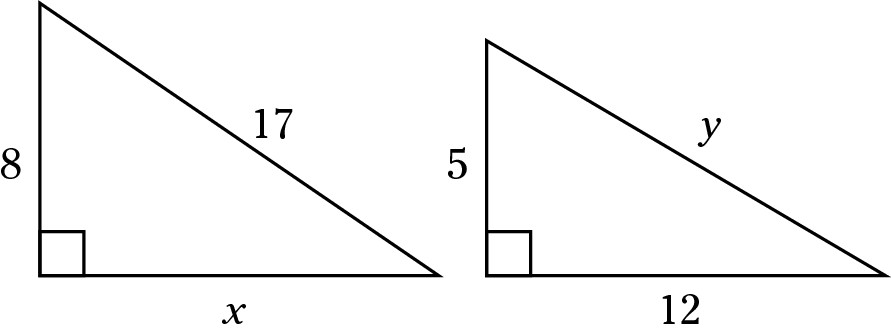

6. 

7. Rolling two six-sided dice

8. Sixteen ounces of lemonade mix makes two gallons of lemonade. (One gallon = four quarts.)

9. Bob traveled 40 percent of the distance of his trip alone, went another 20 miles with Anthony, and then finished the last half of the trip alone. How many miles was the trip?
A 240
B 200
C 160
D 100
E 50
Questions 10 and 11 refer to the following graphs.
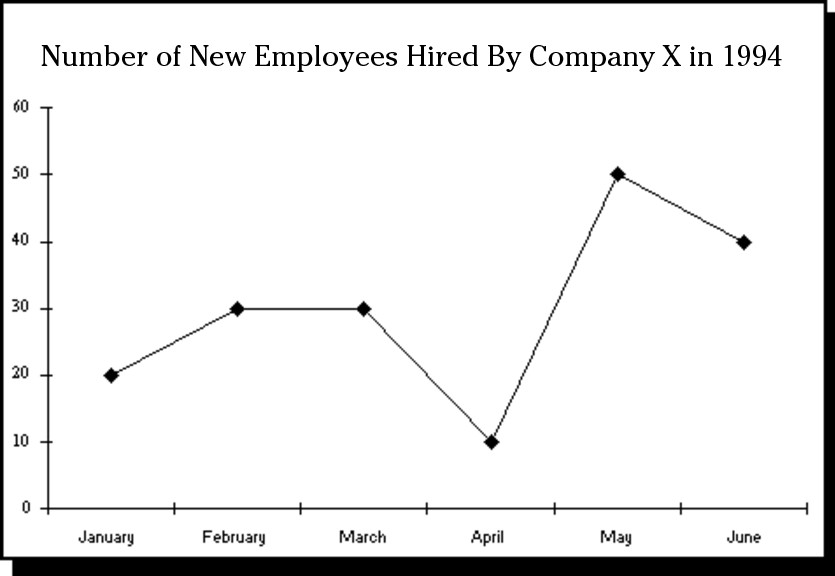
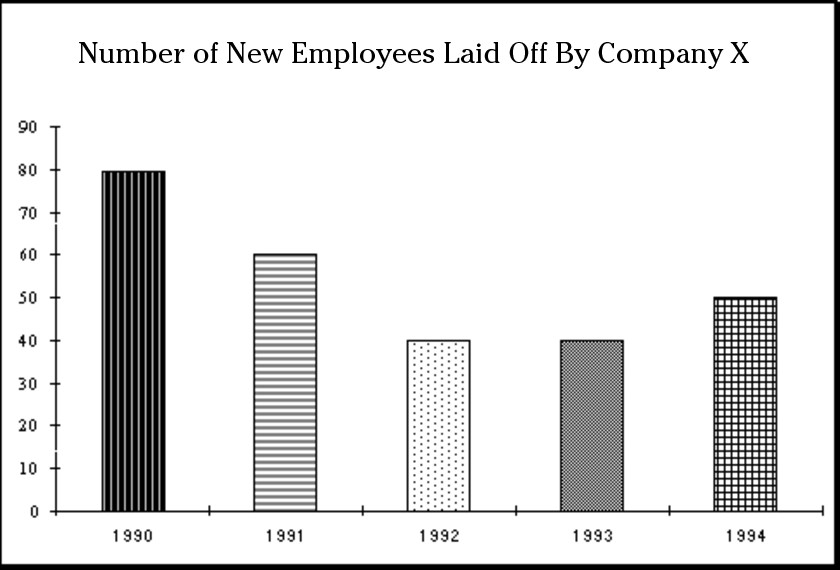
10. If new employees hired in May 1994 were  of the total employees, new employees laid off in 1994 would be what percent of the total employees in the company?
of the total employees, new employees laid off in 1994 would be what percent of the total employees in the company?
A 60
B 50
C 
D 24
E 20
11. In 1995, the increase in the percentage of new employees laid off over that of the previous year was the same as the increase in the percentage of new employees hired between January and February of 1994. How many new employees were laid off in 1995?
A 10
B 20
C 50
D 60
E 75
12. Now in his second year at the firm, Carlos is earning an annual salary of $37,450. At the beginning of the year, he received a 7% raise. What was Carlos’s starting salary?
Give your answer to the nearest thousand.

13. Jerry drives 30 miles an hour for two and a half hours. Susan goes the same distance but drives 40 miles per hour. How many hours does Susan drive?
A 37.5
B 
C 2
D 
E 2.5
14. Out of a class of 25 students, the teacher must choose 5 to represent the class in the school’s spelling bee. Assuming the teacher chooses randomly, how many different combinations of students could possibly represent the class?
A 5
B 
C 
D 
E 1
15. Of 175 employees, 30 took advantage of prepaid legal services, 165 participated in the company retirement program, and 25 participated in both programs. How many employees did not participate in either program?
A 5
B 10
C 25
D 30
E There is not enough information to answer this question.
For the following question, choose all answer choices that are correct.
16. Common factors of 18 and 48 are
A 9
B 3
C 4
D 6
E 1
F 0
17. –5, 0, 5, –5, 0, 5, –5, 0, 5
In this repeating sequence, what is the sum of the 250th and 251st terms?
A 5
B 10
C –5
D 0
E –10
18. How many ounces of 40% salt solution must be added to 75 ounces of 10% salt solution to make a 35% salt solution?
A 75
B 375
C 150
D 187.5
E 125
19. If  , what is the value of x in terms
, what is the value of x in terms
of y?
A 7y – 5
B xy – 7y – 5
C 
D 
E y – 5 + 7
For the following question, choose all answer choices that are correct.
|
Company |
Q1 Sales |
Q2 Sales |
|
A |
$72,000 |
$80,000 |
|
B |
$50,000 |
$59,000 |
|
C |
$65,000 |
$73,000 |
20. A Company B’s increase in sales from Q1 to Q2 is greater than Company C’s increase in sales from Q1 to Q2.
B Company B’s percentage increase from Q1 to Q2 is higher than that of either of the other two companies.
C Company A’s percentage increase in sales from Q1 to Q2 is greater than Company C’s percentage increase in sales from Q1 to Q2.
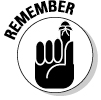 Chances are good that you’ll be taking the computerized GRE, which doesn’t have answer choices marked with A, B, C, D, E, and F. Instead, you’ll see clickable ovals and check boxes, fill-in-the-blank text boxes, and click-a-sentence options (in some Reading Comprehension questions). I formatted the questions and answer choices to make them appear as similar as possible to what you’ll see on the computer-based test, but I had to retain the A, B, C, D, E, F choices for marking your answers.
Chances are good that you’ll be taking the computerized GRE, which doesn’t have answer choices marked with A, B, C, D, E, and F. Instead, you’ll see clickable ovals and check boxes, fill-in-the-blank text boxes, and click-a-sentence options (in some Reading Comprehension questions). I formatted the questions and answer choices to make them appear as similar as possible to what you’ll see on the computer-based test, but I had to retain the A, B, C, D, E, F choices for marking your answers.